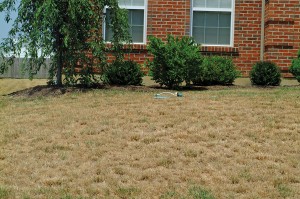Lawn Stress

High temperatures and dry conditions are bad enough for your turf, but add in the insects and diseases that summer always brings, and your lawn could be in need of some serious help.
Signs of a stressed lawn
Drought and lack of watering often lead to bluish-green coloring or footprints that remain in the turf after you’ve walked on it. If insects or diseases are present, you may also notice brown patches or chewed grass blades.
Stopping stress before it starts
Healthy lawns are less likely to fall victim to summer stress, making proper watering, mowing and fertilization extra important in hotter weather.
Be sure that your turf gets from 1″ to 1 ½” of water per week from rainfall or watering. When sprinkling, let water soak in to a depth of 6″ so that enough moisture reaches the roots.
Set your mower blade height so that no more than ⅓ of the grass blade is removed with each cutting. To avoid shredding the tips of your grass blades (which makes it easier for diseases to invade), your mower blades should be sharpened three to four times per season.
Finally, remember that regular applications of fertilizer will help your turf to stand up to insects and disease while decreasing its water requirements throughout the summer months.
For more information on helping your lawn stand up to summer stress, give Arbor Care a call today.

